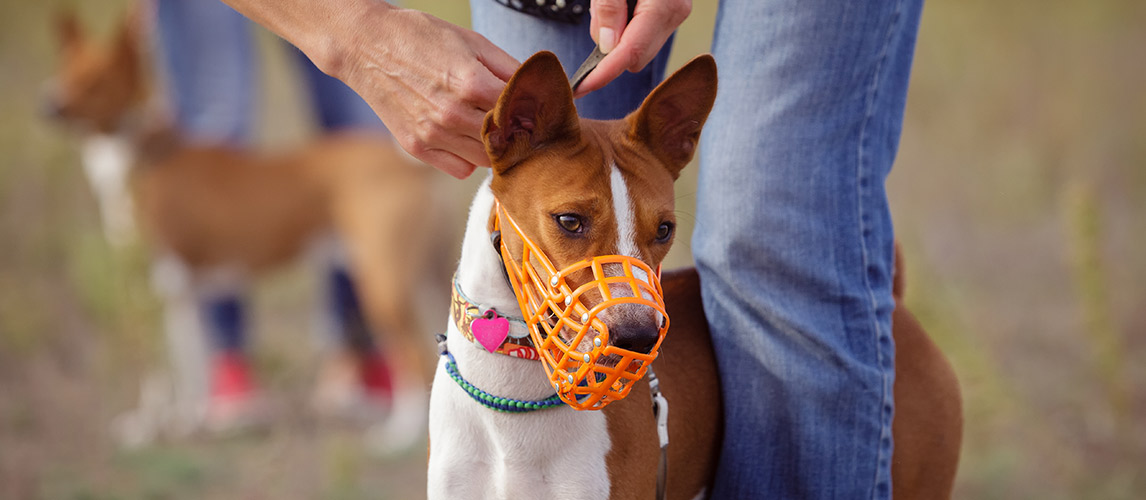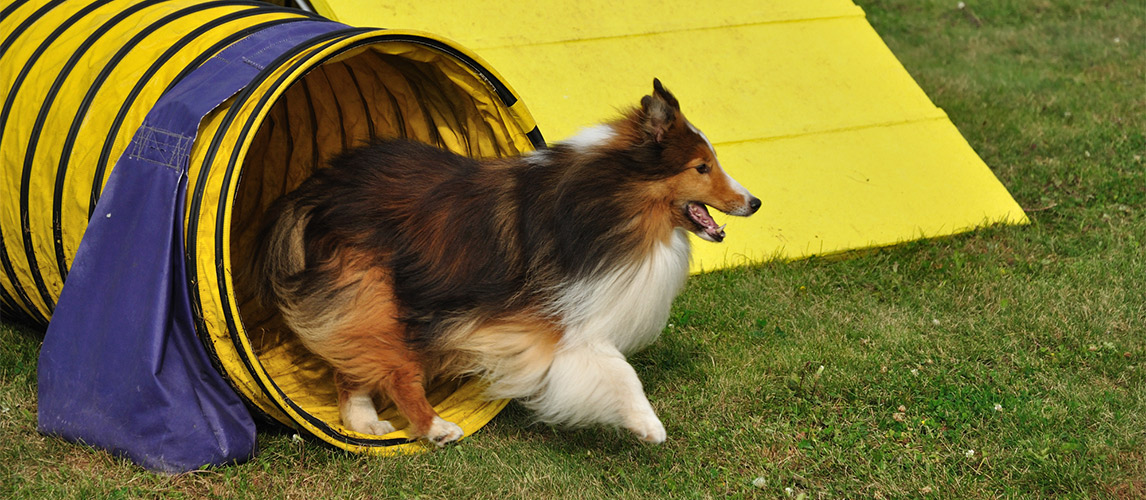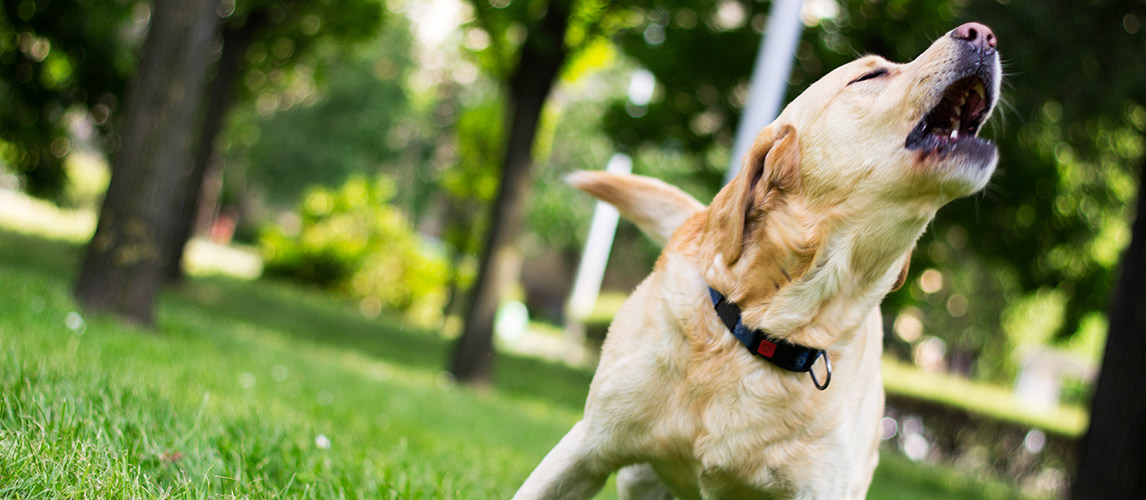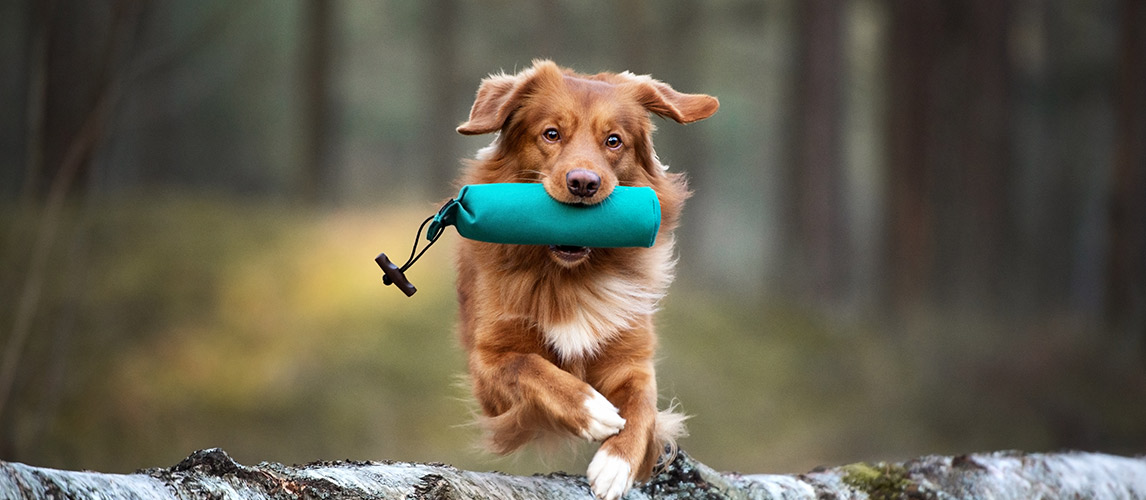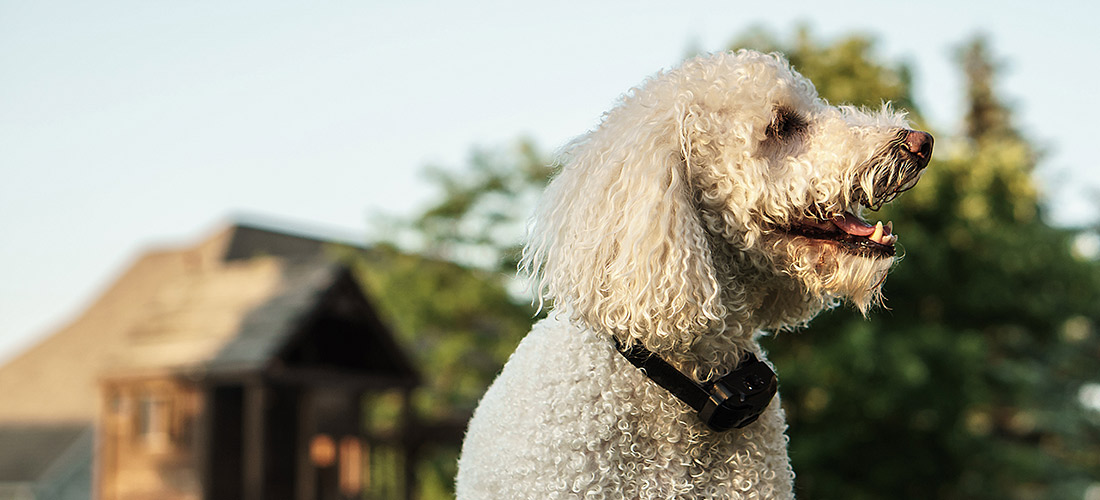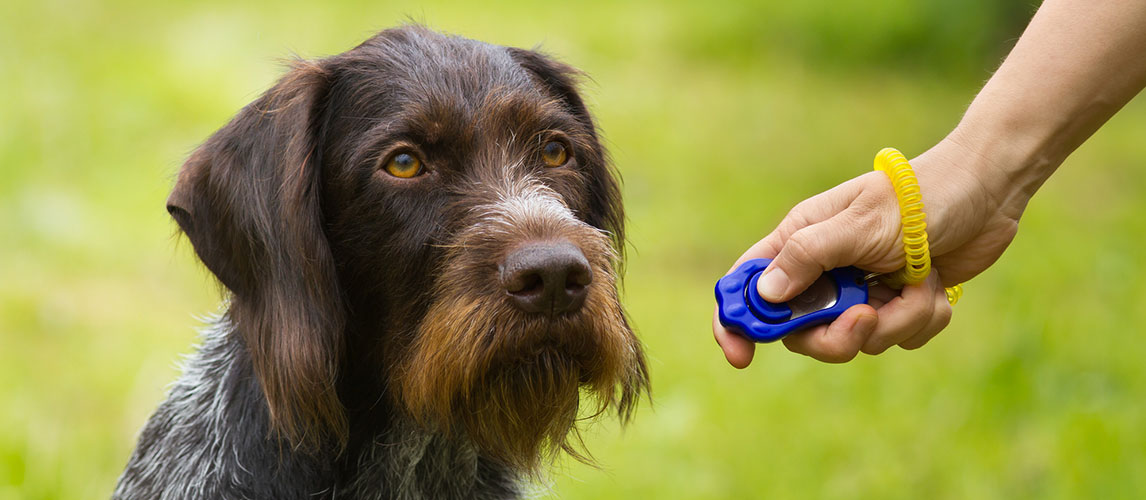Mental stimulation for dogs encompasses many interactions and activities and enriches a dog’s life by giving them something meaningful to do. Additionally, because these activities alleviate boredom, they decrease the likelihood of our dogs developing behavioral issues such as excessive chewing or barking. Not only that but providing your dog with new ways to stay entertained can help to strengthen the bond between you and your canine friend. Especially if you choose to stimulate them via training methods. There are many ways to give your dog the entertainment they need to stay happy, and here are our top 10.
1. Teach Your Dog Some New Tricks
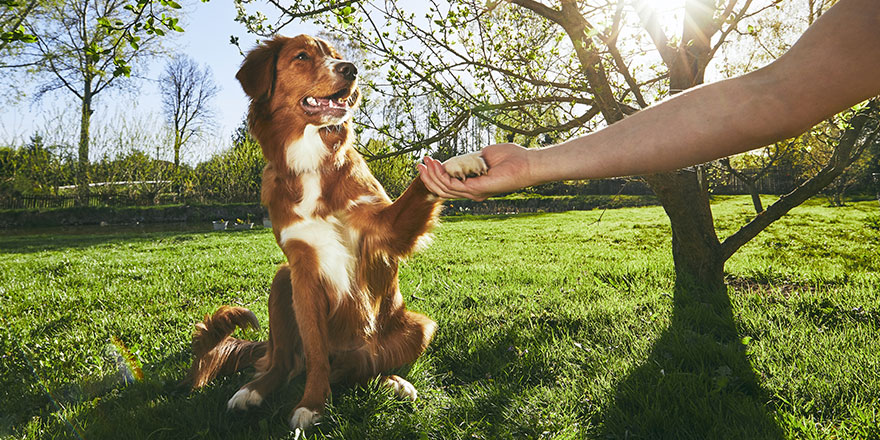
Teaching your dog a new trick is a great way to provide your dog with some effective mental stimulation. Learning new commands can also help increase your dog’s focus and impulse control, making it the ideal choice for troublesome dogs. A favored trick of many dog owners is teaching your dog to weave between your legs. It looks impressive, but it was surprisingly one of the easiest tricks to teach, so long as you’re not trying to teach it to a Great Dane. All that training will help boost your dog’s confidence and strengthen the bond between dog & owner. Never believe the old saying “you can’t teach a dog new tricks”, it is simply a matter of putting in the effort and perseverance. Here are a few easy tricks you could try with your dog:
- Paw: Train your dog to place its paw in your hand on request. Some people also call this “shake” or “high-five”.
- Beg: See if you can get your dog to sit back on their hind legs and lift its front ones in an almost pleading gesture. This is generally done by guiding your dog to lean back on its feet in pursuit of some food.
- Rollover: This sounds difficult, but if you’ve managed to train your dog to lie down, you simply have to get them to follow some food around their head with their eyes until they roll one way or the other.
- Heel/Come: This simple trick could save you a lot of hassle when out on a walk. Teach your dog to stay by your side at your command or return to you if they wander too far. Lots of coercion with their favorite treats as a reward and plenty of patience needed for this one.
2. Teach Your Dog the Names of Each Toy
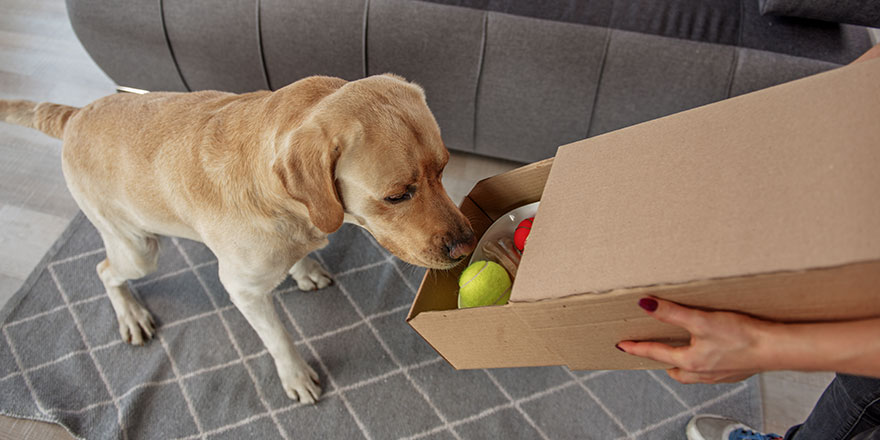
Many dogs love the ‘go find it’ game, and it’s a game that can be played with dog toys as well as treats. Dog’s minds are as unlimited as humans when it comes to learning simple commands, and by getting them to remember the names of all of their toys, you provide them with a little brain teaser every time you request a specific toy from them. To do this, you’ll want to play a game of hiding and seek with their favorite toy and have them find it. Eventually, they will retain the names of the toys you have been hiding.
The first step is making sure your dog knows the name of the item you’re going to be hiding. Once your dog has successfully found the toy with ease a few times, you can start to add new toys to the mix to widen the net. Just be sure to go slowly to ensure your dog knows the name of the first toy before you move on or add another. Eventually, you’ll be able to request a specific toy from their toy box, and they will be able to easily fetch it.
Check out some of our dog toy guides, such as Dog Puzzle Toys, Tug Toys For Dogs, and Indestructible Dog Toys.
3. Your Dog Can Work For Its Treats
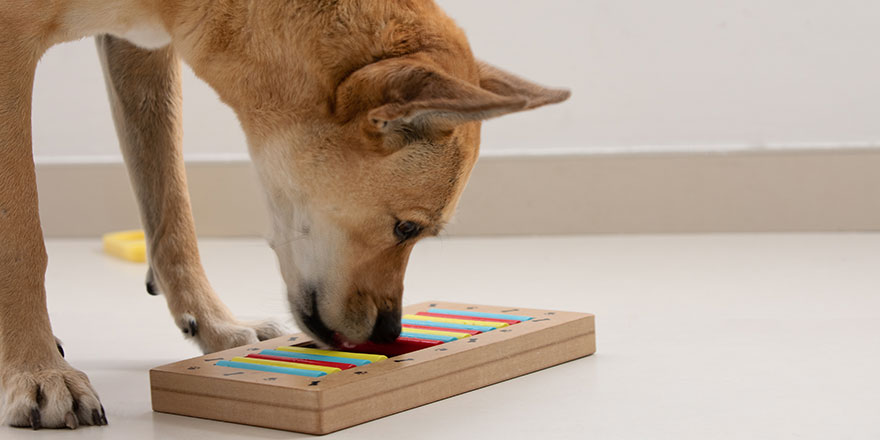
Interactive toys like Bob-A-Lots and Kong wobblers encourage your dog to use its cognitive ability to get to its hidden treats. You place your dog’s meals in the toy, and they have to roll it around to get the food out of the hole. And yes – it can be a bit noisy, but it’s well worth it when you see how satisfying it is for your dogs. Your dog has it pretty easy when it comes to mealtime. Which is a far cry from their natural scavenging habits. A kong filled with peanut butter or pate and then frozen has repeatedly proven to be a great way to keep dogs mentally stimulated for a long time. Additionally, the tug-a-jug dog toy has proven to be quite trickier than many other toys, combining a treat dispenser with a difficult puzzle for your dog to solve.
Many dogs find new ways of using interactive dog toys that have never been considered. This makes the experience quite fascinating as a spectator, as you can watch how your dog’s brain works it out.
Take a look at our guides on the Best Dog Safe Peanut Butter Treats, Best Dog Treats, and Best Dog Jerky Treats.
4. Try Some Interactive Play
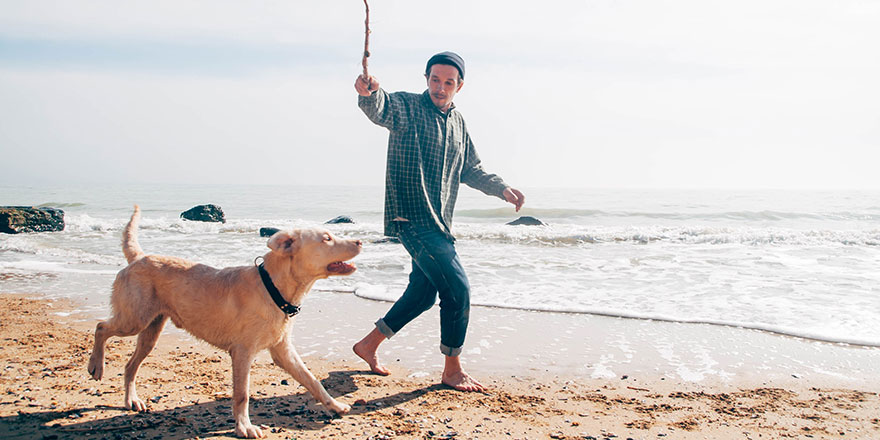
There are a plethora of fun games you can choose from that require little more than a tennis ball or a piece of rope. Interactive play means getting down to your dog’s level and playing with them as you would a packmate.
Physical Interactive Play
Don’t be afraid to get physical; wrestle with them, play hide and seek, or try a fun game of tug of war, bounce around with them, and let them know they can play with you too. It’s a very effective way of bonding with a new puppy or re-establishing a bond with old ones. With the more physically involved playing, just be sure to train your dog to stop when you tell them to. An effective command is “leave”; not only does this work to get your dog to drop its toy, but it can also work to get them to leave you alone.
Classic Interactive Play
Outside the hands-on playtime games are the more classic mental exercises for dogs, such as the time-honored game of “fetch”. When it comes to your dog, mental stimulation exercises are not only great for keeping sluggishness at bay, but the right mental stimulation helps keep your dog mentally sharp and physically fit with the inclusion of physical exercise – such as walking and ball chasing. You can even use a game of fetch as a chance to get some command training and a bit of fresh air for you and your dog. You can give your dog the chance to learn the name of their ball to help with a game of “go find it”. You can even teach them “leave”, “sit”, “stay,” and “heel”, with lots of belly rubs and treats as a reward.
You may also like our article on the Best Automatic Fetch Machines.
5. Bring Out A Sensory Interactive Dog Toy
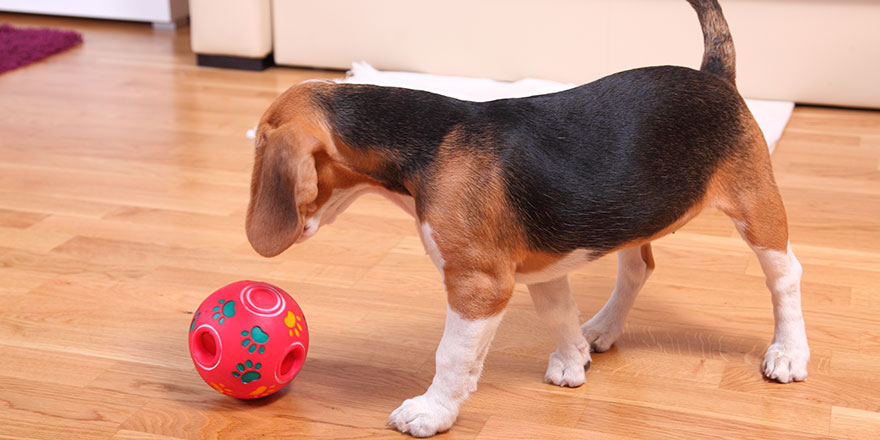
Mental stimulation for dogs doesn’t always have to mean exercises, games, and puzzles. Some dogs like to explore the sensory side of interactive toys, such as scent games, as well as toys and games that rely on feel, sounds, and even color. Looking into something like a snuffle mat, multi-textured chew toy, a crinkle toy, or even a squeaky toy would be a good idea to give your dog mental stimulation from a different angle.
Think of your four-legged friend as you would a human baby. They require lots of care and attention, love to be around their pet parents, and need the right kind of mental stimulation exercises to support their development and cognitive function – even in old age. Older dogs can’t move around as they did when they were a puppy and often struggle to keep up with regular walks and exercise. Therefore, finding an interactive dog toy they can enjoy without needing to get up and run around can be all the mental stimulation they need. Helping to keep your dog busy and your dog’s mind active when treats and wrestling are off the table.
6. Get Your Dog a Puzzle Toy
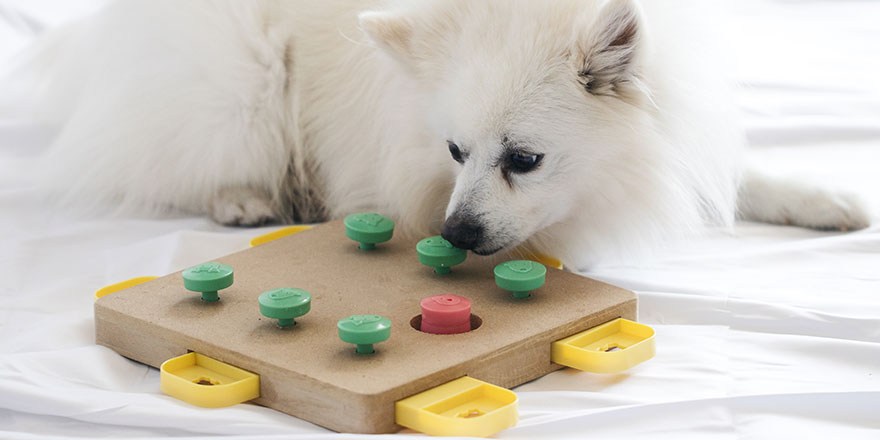
Interactive toys like puzzles help keep your dog focused on a task, and that added extra mental stimulation goes a long way. If you’re not sure of the kind of puzzle toys your dog would be interested in, you can create puzzle games using household items to test the water:
- Tennis Ball Tray: Grab a muffin tin and some tennis balls and simply watch your dog bat and sniff them. For something extra, try adding faint scents to each ball as a special treat to pique their interest. This could be rubbing an orange peel on one or perhaps putting a few dog-friendly flower petals inside one of them. The selection of scents combined with the challenge and intrigue of removing and replacing the balls could turn this into your dog’s new favorite game (scent games are often very popular with dogs).
- Denim Knot: If you’ve got an old pair of jeans you don’t need anymore, you may try making a denim knot as a budget toy to try out a new form of mental stimulation. This is done by cutting the legs from your jeans and knotting the two legs together in a square knot. You could even hide some treats in the layers of the knot and encourage your dog to retrieve them.
- Treat Bottle: Before shelling out to get one of the more heavy-duty, long-lasting treat puzzle toys, you might want to try your pup with a simpler puzzle toy design. Like a water bottle with a few treats inside. The water bottle will add a sensory element, crinkling as your happy dog chews down on it. Whereas the treat itself will provide a reward, enticing them to try it again.
These are just a few examples of how you can test the waters with puzzle play before committing to the more long-lasting, hard-wearing puzzle toy options. So if you’re unsure if your dog is into puzzles, I suggest making one out of a muffin tin & tennis balls to gauge their interest. Not all puzzle toys are loved equally by every dog.
7. Agility Training
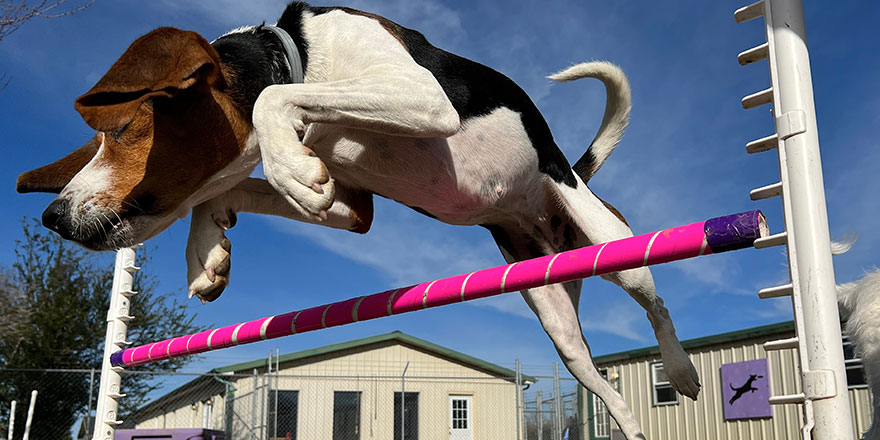
Some dogs are far too high-energy to let loose around the house. The best way to combat that energy is with high-energy mental stimulation exercises, and what better way to exercise the more excitable bored dogs than with an agility course? These training kits can be found in various places, allowing you to set up a course in your backyard as a treat for your pup. The more mental stimulation your pup receives along with its exercise, the more worn out they will be when they’re done. We’ve all been there – that feeling of complete mental exhaustion after a long day of focusing on something that exercises our brain. This training course combined that with the physical exercise required to keep a healthy dog fit and a seemingly insatiable dog satisfied.
Suppose you’re needing to encourage a nervous dog to get involved in these more difficult yet rewarding mental stimulation exercises. In that case, you could always hide treats underneath the tunnel to entice them. Once your pup gets over its nerves and is rewarded with hidden treats, the real fun begins. But just remember, though this training style will start as a new game, it will become work if you keep on top of it properly, so remember to reward them regularly for their efforts.
Find out more about Dog Agility Tunnels.
8. Socialize Your Dog
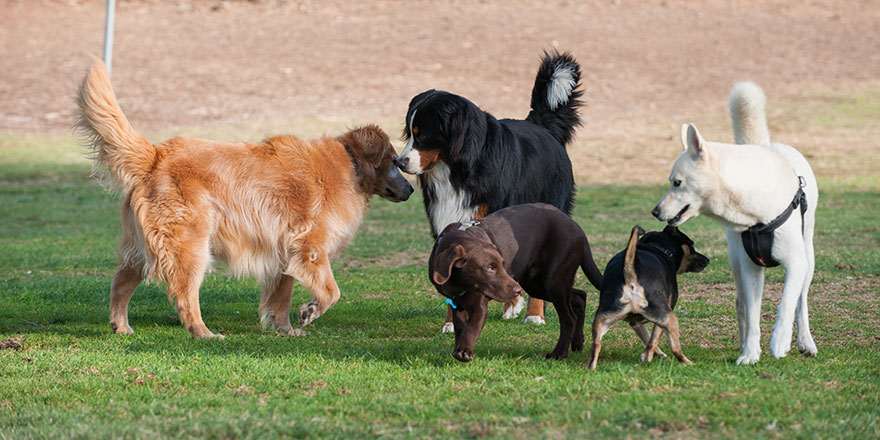
Mental stimulation exercises don’t just come from games and training. Try your pup with some new faces – be it a friend visiting or walking to the dog park to meet other dogs. Dogs get more mental stimulation from meeting new people than you might think, and the experience can be likened to playtime with a puzzle toy. It can be draining over long periods but also a lot of fun.
When figuring out how to stimulate a dog, you probably wouldn’t put “meeting strangers” at the top of your list. But imagine how it feels to go to a party full of people, most of whom you don’t know – exciting but exhausting, right? It’s the same for dogs. Though a dog or puppy will engage a stranger more than we humans would. Just be wary when introducing your dog to kids; while your dog may be the biggest softie in the world, children can be unintentionally heavy-handed, which can be stressful for your pup.
9. Run Errands With Your Dog
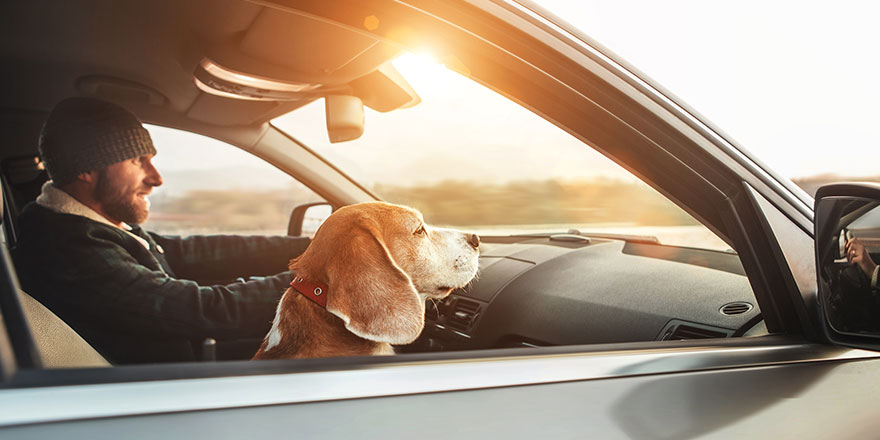
It’s no puzzle toy, but dogs get more mental stimulation from doing a series of small tasks than they would go for their daily walk. While the daily walk is fun and helps to keep on top of your dog’s health and fitness, running errands will keep their mind ticking. This can be as simple as taking them down the street to the post box, sitting in while you run the car through the car wash, or stopping off at a friend’s house for a coffee. The wide variety of stimulants your dog would be introduced to will certainly help curb their boredom, not including the exercise they would get from being out of the house with you.
10. Purchase an Automatic Treat Dispenser
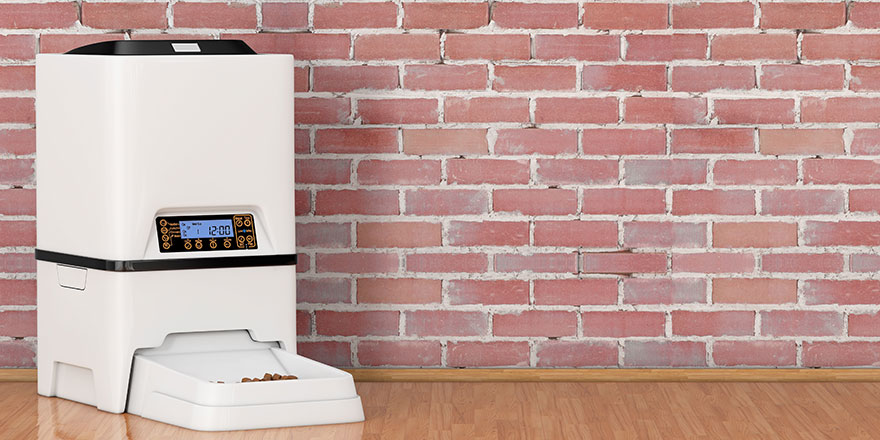
Automatic treat dispensers can be a great support for dog parents that are away from home a lot. Many of the treat dispensers on the market will throw several treats at your dog each time it is triggered. You can also set it to dispense treats at set times throughout the day. While it may not be a “toy” per se, it is a well-known fact that a treat will go a long way with almost any puppy, and a treat dispenser can help ensure your dog is getting exercise during the day by having to get up and move around to retrieve the treat that has just been dropped.
Check out our article on the Best Automatic Dog Feeders.
Try Not To Overload Them
Dogs, like humans, can become overwhelmed when an environment becomes too stimulating and too much is happening at once. Your dog may love a puzzle toy, but avoid giving them too many toys at once. If your puppy enjoys having a good chew on something, try and limit the things they have available to chew so as not to provide too many options. Let your dog leave the area and have some quiet time if they need to. There is no harm in a dog wanting a rest after a lot of play; a calm moment can do a world of good when they’ve been tired out. More mental stimulation can come later, along with more play, but overdoing it will just discourage them from getting involved in the future.
Once they have had time to recuperate, they will likely sniff their way back to you, ball in mouth, ready to play again. Because, as we all know, every puppy adores its owner and lives to play, keep the treats handy, and prepare for more puppy fun!
Sources:
- Lisa J Wallis, Utilising Dog-computer Interactions To Provide Mental Stimulation In Dogs Especially During Ageing, The ACM Digital
- Brain Games For Dogs, Animal Humane Society
- Leslie Darling, Mind Exercises for Dogs, The Nest
- How to Entertain Your Dog, HowStuffWorks
- Mara Ratnofsky, DVM, 5 Simple Ways to Improve Your Dog’s Quality of Life, The MSPCA–Angell
Frequently Asked Questions
Dogs need mental stimulation to keep them busy and avoid boredom. However, it doesn’t just come down to that. Especially intelligent breeds have a habit of becoming destructive when they have had nothing interesting to do for too long. You can also have this problem with puppies, as they are particularly active. If you have a dog with no friend to play with in your absence, you may find they play with the furniture instead (many pups enjoy a good tug on the curtains). Mental stimulation is a key factor in keeping these destructive tendencies at bay.
This is one of the simpler ways to entertain your dog. While chewing a raw bone is certainly enjoyable for them, it does not provide the same mental stimulation as a more active task such as training or puzzle solving. If you’re in a pinch and need to refocus your dog’s energy somewhere else for a moment, providing them with a nice juicy raw bone to chomp down on can be the perfect distraction.
You may also like our guide on the Best Dog Bones.
Car rides can be several things for a dog. Depending on the dog and the context of the journey, they could be enjoyable, stressful, exciting, anxiety-inducing, or relaxing. For dogs that tend to lay down in the back and go to sleep during a road trip, it is not particularly stimulated – as signified by their sleeping. On the other hand, if your dog becomes stressed or anxious during a journey, while it is indeed stimulating, it is not worth the negative impact a car journey would have on your dog’s mental health.
Most of the time, dogs enjoy a good car ride, sticking their head out of the window, woofing at passing pedestrians, or simply watching the world go by. These dogs benefit from the occasional car journey as a change of pace for them. However, it is worth noting that car rides should never be used as the key form of mental stimulation – as there is a lot more to keep your dog entertained than just sticking it in the back of your car and setting off.
Absolutely! The Kong company highly recommends toys for pet parents alongside other interactive treat toys such as a Bob-a-Lot. When it comes to piecing together a plan for how to mentally stimulate your dog, treat toys can go to the top of the list. Just pop your dog’s favorite treat into the toy, and let your dog be motivated by the treat to figure out how best to remove it. They make fantastic brain games for dogs – especially puppies.
Note: The advice provided in this post is intended for informational purposes and does not constitute medical advice regarding pets. For an accurate diagnosis of your pet's condition, please make an appointment with your vet.


